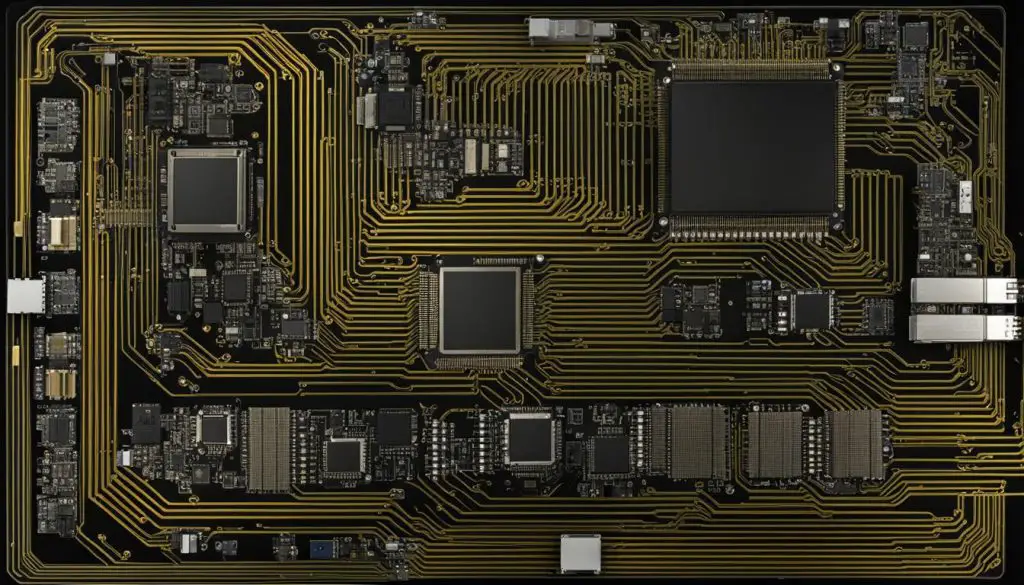Understanding Computing: What is the Kernel?
Welcome to my article on understanding the kernel, a fundamental component of computer operating systems. In this section, we will explore what the kernel is, its definition, and how it functions within a computer system.
The kernel serves as the essential foundation of an operating system, acting as the main layer between the software and the underlying hardware. It provides basic services for all other parts of the operating system, including process and memory management, file systems, device control, and networking.
If the kernel is damaged or unable to load successfully, it can prevent the computer from starting at all. This highlights its crucial role in the overall functioning of a computer system.
Key Takeaways:
- The kernel is the core component of an operating system.
- It acts as the interface between software and hardware.
- The kernel provides essential services for the operating system.
- If the kernel is damaged, the computer may not start.
- Understanding the kernel is crucial to comprehending computing systems.
The Purpose of the Kernel
The kernel serves several crucial functions in an operating system, making it a vital component of computer systems. Its importance lies in its ability to provide necessary interfaces for users and applications, launch and manage applications, and manage the underlying hardware devices. The kernel acts as a bridge between the software and hardware, ensuring efficient performance and overall system functioning.
Kernel Functions
The kernel performs three primary functions:
- Interface: It provides the necessary interfaces for users and applications to interact with the computer. This includes handling user input, displaying output, and managing system resources.
- Application Management: It launches and manages applications on the system, ensuring they have the resources they need to run efficiently. It also handles task scheduling, process management, and resource allocation.
- Hardware Management: It manages the underlying hardware devices of the system, including communication with peripherals, device drivers, and handling input/output operations.
By fulfilling these functions, the kernel ensures seamless communication and coordination between software and hardware, optimizing system performance and providing a stable and reliable operating environment.
Kernel Design
Kernel design plays a crucial role in determining the efficiency and effectiveness of an operating system. There are different types of kernel architectures, each with its own advantages and tradeoffs.
| Kernel Architecture | Advantages | Tradeoffs |
|---|---|---|
| Monolithic Kernel | Efficient design, direct access to hardware, high performance | Higher risk of system crashes, less modular |
| Microkernel | Enhanced modularity, better isolation, increased resilience | Potentially reduced performance |
| Hybrid Kernel | Combines advantages of monolithic and microkernel architectures | Complex design, balancing tradeoffs between architectures |
Each architecture has its own design principles and goals, catering to different operating system requirements. The choice of kernel design depends on factors such as performance, reliability, security, and scalability.
Kernel Architecture and Design
In this section, we will explore the different architectures of kernels and their design principles. Understanding the various types of kernels is essential for comprehending the inner workings of operating systems.
Monolithic Kernel
The first type of kernel architecture is the monolithic kernel. In this design, all kernel services are encompassed within a single address space. This approach provides a straightforward and efficient design but comes with a higher risk of system crashes. The Linux kernel is a well-known example of a monolithic kernel.
Microkernel
The second type is the microkernel architecture. Microkernels take a modular approach by delegating user processes and services to different address spaces. This design enhances resilience and modularity, as individual components can be updated or replaced without impacting the entire system. However, this approach may result in reduced performance due to the overhead of inter-process communication. The QNX operating system is based on a microkernel architecture.
Hybrid Kernel
The third type is the hybrid kernel architecture, which combines features from both monolithic and microkernel designs. Hybrid kernels, such as Microsoft Windows NT and Apple XNU, aim to provide a balance between performance and modularity. They retain some services in kernel space for efficiency while moving others to user space for improved isolation and flexibility.
Kernel and Memory Management
Memory management is a critical aspect of the kernel’s operation, ensuring the efficient allocation and utilization of memory resources in a computer system. The kernel plays a vital role in providing each process with the necessary memory space while safeguarding the integrity of the kernel itself.
The kernel utilizes virtual memory techniques to allow each process to have its own virtual memory space, separate from other processes. This prevents applications from crashing or interfering with each other, as each process operates within its allocated memory boundaries. Virtual memory management enables the kernel to efficiently handle memory allocation, deallocation, and swapping of data between physical RAM and secondary storage.
One of the key features of memory management in the kernel is the protection mechanisms it employs. The kernel ensures that processes cannot access memory areas allocated to other processes or the kernel itself, preventing unauthorized modification or interference. By providing isolation and protection, the kernel ensures the stability and security of the overall system.
The following table highlights the essential aspects of kernel memory management:
| Aspect | Description |
|---|---|
| Memory Allocation | The kernel is responsible for allocating memory to processes and managing the available memory resources efficiently. |
| Virtual Memory | The kernel uses virtual memory techniques to provide each process with its own isolated memory space. |
| Protection | The kernel ensures that processes cannot access memory areas allocated to other processes or the kernel itself, preventing unauthorized modification or interference. |
By efficiently managing memory resources and providing protection mechanisms, the kernel plays a crucial role in maintaining the stability, security, and optimal performance of a computer system.
Device Drivers and Kernel Operation
In order for an operating system to effectively communicate with hardware devices, device drivers play a crucial role in the operation of the kernel. Device drivers act as intermediaries between the kernel and various hardware components such as printers, graphics adapters, and network interfaces. These drivers provide the necessary interface for the operating system to control and communicate with the hardware, enabling seamless functionality and performance.
The kernel operates in two distinct modes: kernel mode and user mode. In kernel mode, the kernel has full access to all system resources and can perform privileged operations. On the other hand, user mode restricts direct access to system resources, requiring applications to make system calls to access these resources. The kernel acts as a manager and gatekeeper, ensuring that user applications have controlled access to the hardware and preventing unauthorized operations.
Overall, device drivers and the kernel’s operation are essential components of an operating system, enabling efficient communication between software and hardware. By providing the necessary interfaces and managing the system’s resources, the kernel ensures smooth functionality and optimal performance for all types of devices connected to the computer system.

Table: Types of Device Drivers
| Driver Type | Description |
|---|---|
| Kernel Mode Drivers | These drivers run in kernel mode and have direct access to system resources. They provide efficient and high-performance communication between the kernel and hardware devices. |
| User Mode Drivers | User mode drivers operate in user mode and require the kernel to act as an intermediary for accessing system resources. They provide a higher level of security and isolation but may have reduced performance compared to kernel mode drivers. |
Key Takeaways:
- Device drivers facilitate communication between the kernel and hardware devices in an operating system.
- The kernel operates in two modes: kernel mode and user mode. Kernel mode allows full access to system resources, while user mode restricts direct access and requires system calls.
- There are different types of device drivers, including kernel mode drivers and user mode drivers. Kernel mode drivers have direct access to system resources, while user mode drivers rely on the kernel for accessing resources.
Kernel and Input/Output Devices
The kernel is responsible for managing input/output (I/O) devices of a computer system, including peripherals like keyboards, mice, disk drives, printers, and network adapters. It provides convenient methods for applications to interact with these devices, abstracting their implementation details. The kernel ensures proper functioning of these devices and handles requests for input and output operations from software applications. I/O management is a crucial aspect of the kernel’s role in facilitating communication between software and hardware components.
| I/O Device | Description |
|---|---|
| Keyboard | Allows users to input text and commands into the computer system. |
| Mouse | Enables users to interact with graphical interfaces through cursor movement and button clicks. |
| Disk Drives | Provide long-term storage for data, files, and operating system installations. |
| Printers | Allows users to produce physical copies of digital documents and images. |
| Network Adapters | Facilitate communication between computer systems over local area networks (LANs) or the internet. |
“The kernel’s role in managing input/output devices is crucial for the overall functioning of a computer system. By abstracting the complexities of device implementation, the kernel allows software applications to interact with peripherals in a standardized and efficient manner.”
I/O Device Management in the Kernel
The kernel employs various techniques and algorithms to manage I/O devices effectively. It utilizes device drivers, which function as intermediary software components between the kernel and specific devices. These drivers enable the kernel to communicate with different types of hardware and provide a unified interface for software applications to access the devices.
- The kernel supports device detection and enumeration, recognizing when new devices are connected or disconnected from the system.
- It handles device initialization and configuration, ensuring that devices are properly set up and ready for operation.
- The kernel manages device interrupts, which are signals sent by devices to request attention from the operating system. It prioritizes and handles these interrupts to ensure timely and efficient device communication.
- I/O scheduling algorithms are implemented to optimize the use of device resources, prioritizing requests from different processes and ensuring fair sharing of device access.
By efficiently managing input/output devices, the kernel enables software applications to make use of these peripherals seamlessly, enhancing the overall user experience and system performance.
The Kernel System Calls
The kernel provides a set of system calls that act as the interface between user-level applications and the underlying operating system. These system calls allow applications to request various services and resources from the kernel, such as file operations, memory allocation, and process management. System calls are essential for applications to interact with the kernel’s functionality and access the underlying operating system interfaces.
When a process needs to perform an operation that requires privileged access or hardware interaction, it invokes a system call. These calls are typically made through wrapper functions provided by the programming language or library, abstracting the low-level details of the system call implementation. By utilizing system calls, applications can safely and efficiently utilize kernel services and access the capabilities of the operating system.
“System calls are a fundamental mechanism through which processes request services from the kernel.”
System calls provide a standardized and controlled way for applications to interact with the kernel. They enforce access permissions, ensuring that only authorized processes can perform certain operations. System calls also enable the kernel to maintain the integrity and security of the system by supervising and regulating the activities of user processes.
Common System Calls
Here are some examples of commonly used system calls:
- open(): Opens a file for reading or writing
- read(): Reads data from a file or input stream
- write(): Writes data to a file or output stream
- fork(): Creates a new process by duplicating the existing process
- exec(): Replaces the current process with a new executable file
- exit(): Terminates the current process and returns the exit status to the parent process
Summary
System calls are a fundamental aspect of the kernel’s operation, providing user-level applications with a well-defined interface for accessing the services and resources of the operating system. By invoking system calls, applications can interact with the kernel’s functionality and perform operations that require privileged access or hardware interaction. Common system calls include open(), read(), write(), fork(), exec(), and exit(). Understanding and utilizing system calls is crucial for developing efficient and secure applications on top of the kernel.
The Kernel’s Role in Resource Management
Resource management is a crucial aspect of the kernel’s operation within a computer system. The kernel acts as a manager, ensuring efficient allocation and proper utilization of resources such as memory, CPU, and devices. It defines execution domains or address spaces, allowing processes to access and use resources securely.
Synchronization and Inter-process Communication
In order to prevent conflicts and ensure coordination between processes, the kernel provides mechanisms for synchronization. These mechanisms allow processes to access shared resources in a mutually exclusive manner, preventing data corruption and inconsistencies. Synchronization ensures that processes can communicate and coordinate their activities effectively.
The kernel also facilitates inter-process communication (IPC), which enables processes to share data and exchange messages. IPC mechanisms provided by the kernel include shared memory, message passing, and semaphores. These mechanisms allow processes to collaborate and exchange information, enabling efficient coordination and cooperation within the system.
| Resource Management in the Kernel | Synchronization | Inter-process Communication |
|---|---|---|
| The kernel manages and allocates resources such as memory, CPU, and devices | Ensures mutually exclusive access to shared resources | Facilitates data sharing and message passing between processes |
| Optimizes resource utilization and prevents conflicts | Prevents data corruption and maintains data integrity | Enables collaboration and coordination between processes |
| Manages execution domains or address spaces | Provides synchronization mechanisms like locks, semaphores, and barriers | Supports communication mechanisms such as shared memory and message queues |
The kernel’s role in resource management is critical for the overall performance and stability of the operating system. By efficiently managing and allocating resources, handling conflicts, and facilitating synchronization and communication between processes, the kernel ensures the smooth operation of the system and enables efficient utilization of hardware resources.
Different Types of Kernels
When it comes to operating systems, there are three main types of kernels that are commonly used: monolithic, microkernel, and hybrid. Each type has its own architectural design and tradeoffs, catering to different needs and priorities.
Monolithic Kernel
A monolithic kernel encompasses all essential kernel functions in a single address space. This design provides a straightforward and efficient system but comes with a higher risk of system crashes. Monolithic kernels are known for their efficiency and simplicity, making them suitable for systems where performance is a priority.
Microkernel
In contrast, a microkernel delegates most services to user space, enhancing modularity and resilience. By separating user processes and services into different address spaces, microkernels provide better isolation and stability. While this architecture offers improved security and flexibility, it may result in reduced performance due to the need for interprocess communication.
Hybrid Kernel
A hybrid kernel, as the name suggests, combines features of both monolithic and microkernel architectures. Examples of operating systems that utilize hybrid kernels include Microsoft Windows NT and Apple XNU. Hybrid kernels aim to achieve a balance between efficiency and stability by leveraging the strengths of both architectures. These kernels offer a combination of performance, flexibility, and security.
| Kernel Type | Advantages | Tradeoffs |
|---|---|---|
| Monolithic | – Efficiency – Simplicity |
– Higher risk of system crashes |
| Microkernel | – Better isolation – Improved security |
– Potential performance reduction – Increased complexity due to interprocess communication |
| Hybrid | – Performance – Flexibility – Security |
– Balancing tradeoffs between monolithic and microkernel architectures |
Understanding the different types of kernels is essential when it comes to designing and implementing operating systems. Whether prioritizing efficiency, security, or a balance of both, the choice of kernel architecture plays a crucial role in determining the overall performance and stability of a system.
Examples of Popular Kernels
Modern operating systems rely on robust and efficient kernels to manage the interaction between software and hardware. Let’s take a closer look at some of the popular kernels that power these operating systems:
Linux Kernel
The Linux kernel is widely recognized for its stability, security, and scalability. As an open-source monolithic kernel, it encompasses all essential kernel functions within a single address space. This design allows for efficient communication and resource allocation, making Linux a popular choice for various platforms, including servers, desktops, and embedded systems.
Windows NT Kernel
The Windows NT kernel employs a hybrid design, combining features from both monolithic and microkernel architectures. This approach prioritizes security and stability, making it suitable for mainstream desktop and server environments. The Windows NT kernel provides essential services such as process management, memory management, and device drivers, enabling the Windows operating system to deliver a seamless user experience.
macOS Kernel
macOS, the operating system used by Apple computers, utilizes a hybrid kernel based on the Mach kernel. This hybrid design brings together the benefits of a microkernel and a monolithic kernel. By leveraging virtual memory management, inter-process communication, and device drivers, the macOS kernel ensures optimal performance and security for Apple users.
FreeBSD Kernel
FreeBSD adopts a monolithic kernel architecture known for its scalability and performance. It offers a robust and stable foundation for various operating systems, including FreeBSD itself. The FreeBSD kernel provides comprehensive support for networking, file systems, and security features, making it a favored choice for servers and high-performance computing environments.
Android Kernel
Designed specifically for mobile devices, the Android kernel is based on the Linux kernel. It is optimized for performance, flexibility, and power management on smartphones and tablets. The Android kernel enables seamless communication between hardware and applications, empowering developers to create innovative and resource-efficient mobile experiences.
| Kernel | Architecture | Key Features |
|---|---|---|
| Linux Kernel | Monolithic | Stability, scalability, open-source |
| Windows NT Kernel | Hybrid | Security, stability, user-friendly |
| macOS Kernel | Hybrid | Performance, security, Apple ecosystem integration |
| FreeBSD Kernel | Monolithic | Scalability, stability, networking support |
| Android Kernel | Monolithic | Mobile optimization, power management, flexibility |
Conclusion
In conclusion, the kernel is the fundamental component of an operating system, acting as the bridge between software and hardware. It provides essential services like memory and process management, device control, and resource allocation. Understanding the role and architecture of the kernel is crucial for comprehending the functioning of computing systems.
There are different types of kernels, each with its own design and tradeoffs. Monolithic kernels encompass all necessary functions in a single address space, offering efficiency but with a higher risk of system crashes. Microkernels delegate services to user space, enhancing modularity and resilience. Hybrid kernels, like Microsoft Windows NT and Apple XNU, combine features from both monolithic and microkernel architectures.
Popular examples of kernels include the Linux kernel, known for its stability and widespread usage. Windows NT utilizes a hybrid kernel design, focusing on security and stability. macOS uses a hybrid kernel based on the Mach kernel, offering performance and security. FreeBSD employs a monolithic kernel known for its scalability and performance. Android, based on the Linux kernel, provides flexibility and performance for mobile devices.
In summary, the kernel is the essential foundation of an operating system, enabling the interaction between software and hardware. Its functions, architectures, and examples illustrate the intricate workings of computing systems and the critical role the kernel plays in their operation.
FAQ
What is the kernel?
The kernel is the essential foundation of a computer’s operating system (OS). It serves as the main layer between the OS and underlying computer hardware, providing basic services for all other parts of the OS.
What functions does the kernel perform?
The kernel performs three primary functions in an operating system. Firstly, it provides the necessary interfaces for users and applications to interact with the computer. Secondly, it launches and manages applications on the system. Lastly, it manages the underlying hardware devices of the system.
How are kernels categorized?
Kernels can be categorized into three main architectures: monolithic, microkernel, and hybrid. Each kernel type has its own advantages and tradeoffs in terms of flexibility, security, and source code size.
What is the role of the kernel in memory management?
The kernel plays a crucial role in managing and allocating memory resources in a computer system. It ensures that each process has the necessary memory space and protects the kernel itself from interference by separating it in a protected area of memory.
What is the role of device drivers in the kernel’s operation?
Device drivers enable communication between the kernel and hardware devices. They provide an interface for the operating system to control and communicate with peripherals like printers, graphics adapters, and network interfaces.
How does the kernel manage input/output devices?
The kernel is responsible for managing input/output (I/O) devices of a computer system, including peripherals like keyboards, mice, disk drives, printers, and network adapters. It provides convenient methods for applications to interact with these devices, abstracting their implementation details.
What are system calls and how do they relate to the kernel?
System calls are a fundamental mechanism through which processes request services from the kernel. They provide an interface between user-level applications and the kernel’s functionality, allowing applications to access resources and services provided by the kernel.
What role does the kernel play in resource management?
The kernel is responsible for managing and allocating resources such as memory, CPU, and devices within a computer system. It schedules and manages processes or threads, handles conflicts, and facilitates synchronization and communication between them.
What are the different types of kernels?
The three main types of kernels commonly used are monolithic, microkernel, and hybrid. Monolithic kernels encompass all essential kernel functions in a single address space, while microkernels delegate most services to user space. Hybrid kernels combine features of monolithic and microkernel architectures.
What are some examples of popular kernels?
Some examples of popular kernels are the Linux kernel, Windows NT kernel, macOS kernel, FreeBSD kernel, and Android kernel.
- About the Author
- Latest Posts
Mark is a senior content editor at Text-Center.com and has more than 20 years of experience with linux and windows operating systems. He also writes for Biteno.com






